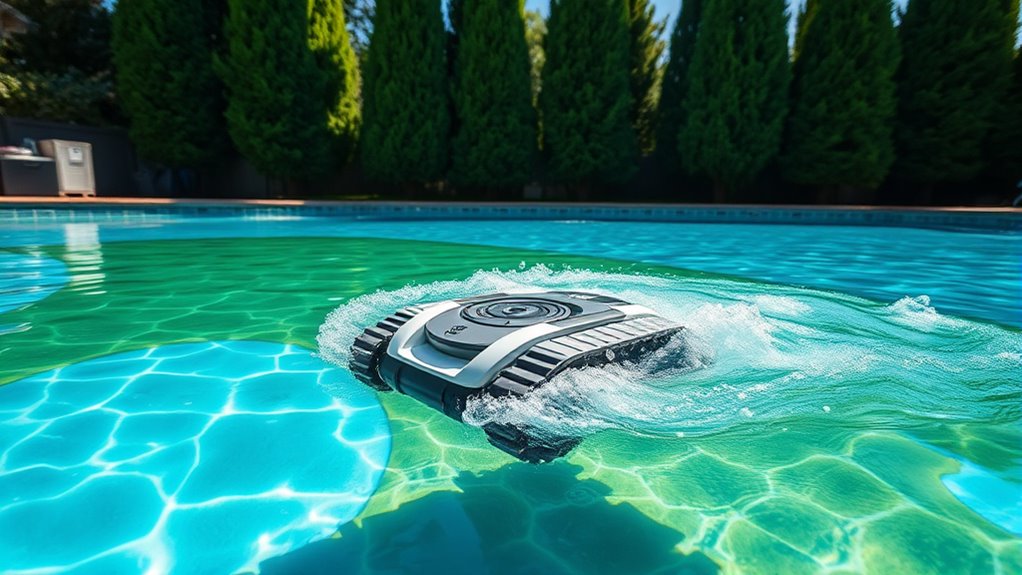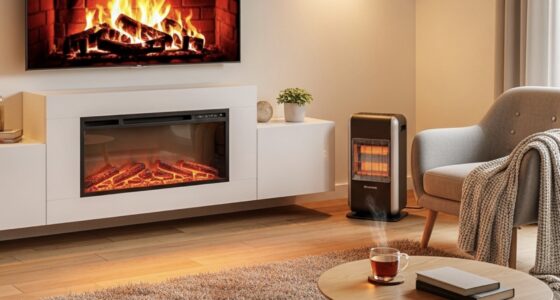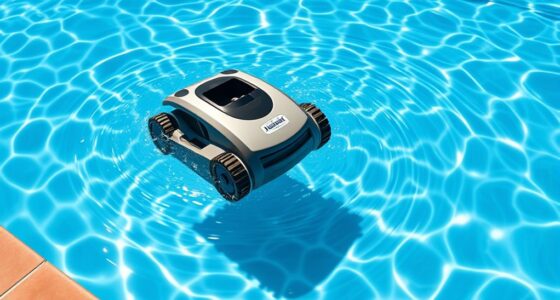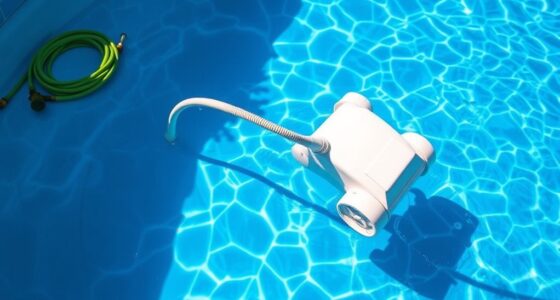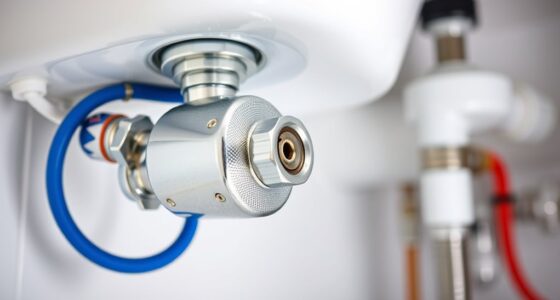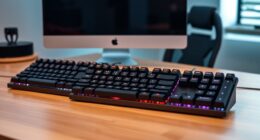Automatic pool cleaners are great for removing surface debris and improving water circulation, but they can’t fully eliminate algae or fix cloudy water on their own. They mainly handle dirt, leaves, and small particles, while algae growth and cloudiness require chemical treatments, manual scrubbing, and proper filtration. To keep your pool crystal clear, you’ll need to combine these tools and techniques. Keep exploring to find out how to get the best results for your pool.
Key Takeaways
- Automatic pool cleaners effectively remove surface debris but struggle to eliminate deeply embedded algae and stubborn cloudiness.
- They improve water circulation and filtration but cannot independently treat chemical imbalances causing algae and cloudiness.
- Robotic cleaners perform better on fine particles and algae spores than suction-side models.
- Manual scrubbing and chemical treatments are necessary for comprehensive algae removal and water clarity.
- Regular maintenance and proper water chemistry are essential to support the effectiveness of automatic pool cleaners.
How Do Automatic Pool Cleaners Work?
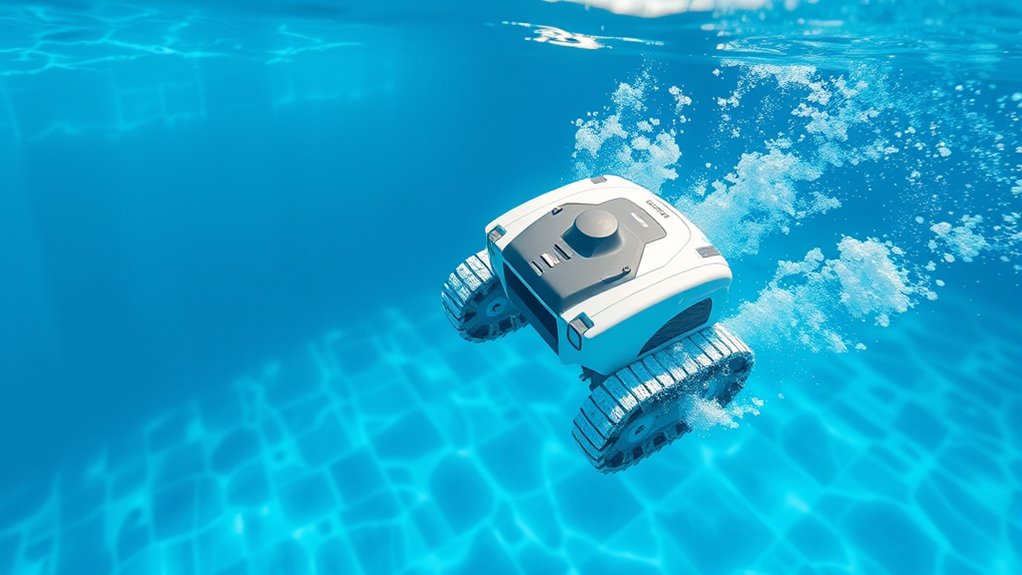
Ever wondered how automatic pool cleaners keep your pool spotless without much effort? It all starts with water circulation. These cleaners rely on your pool’s pump system to move water through their filters, trapping dirt, debris, and algae. They work by navigating your pool’s surfaces, using brushes or suction to dislodge particles. A pool heater isn’t directly involved in cleaning but helps maintain optimal water temperature for comfort and chemical effectiveness. As water circulates, debris gets pulled into the cleaner’s filtration system, which traps contaminants. This continuous process ensures your pool stays clean, reducing manual labor. Additionally, water circulation plays a vital role in distributing chemicals evenly, which helps prevent algae growth and keeps the water clear. Proper circulation also helps enhance filtration efficiency, ensuring debris and algae are removed more effectively. Well-maintained circulation systems are essential for preventing algae buildup, making your pool easier to keep clean. Incorporating regular filter maintenance can further improve the overall cleaning process and water quality.
Capabilities of Robotic and Suction-Side Cleaners in Removing Debris
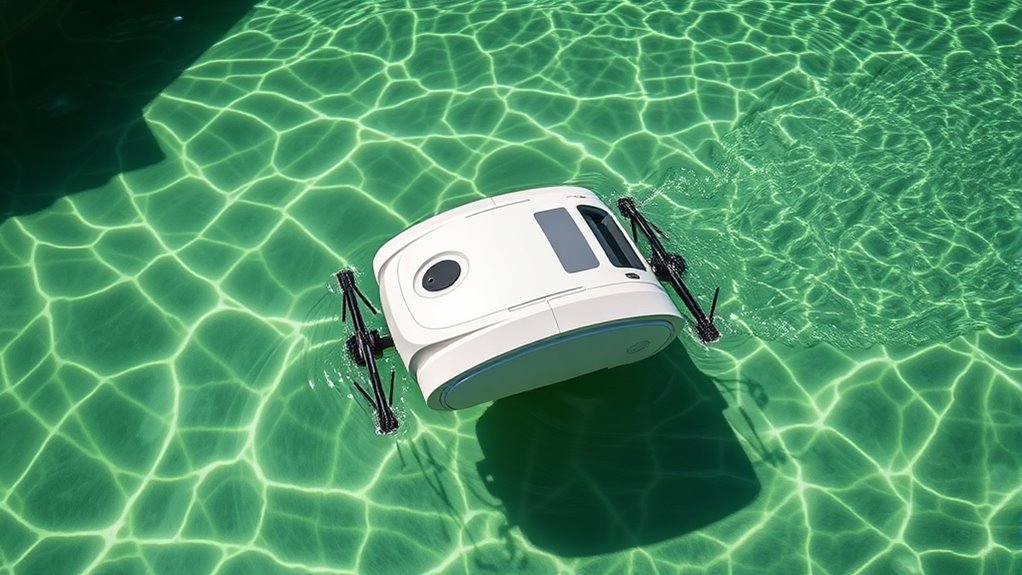
Robotic and suction-side cleaners are designed to pick up debris efficiently, but their effectiveness varies based on several factors. They can cover large surface areas quickly, ensuring your pool stays clean. Additionally, their ability to handle fine particles differs, impacting how well they clear dirt and small debris.
Debris Pickup Efficiency
How effectively do automatic pool cleaners pick up debris from your pool? Robotic and suction-side cleaners excel at removing leaves, dirt, and small particles, improving water clarity quickly. Their debris pickup efficiency depends on the cleaner’s design and your pool’s water filtration system. A well-maintained filter ensures debris is captured and prevents clogs, enhancing cleaning performance. Additionally, if you use pool heating, debris removal helps maintain consistent temperature by reducing organic build-up that can cause algae growth. Robotic cleaners often have powerful suction and brushes that reach corners and steps, while suction-side models rely on your pool’s pump. Proper maintenance of your pool’s filtration system can also improve debris pickup and prolong the lifespan of your cleaner. Overall, these cleaners considerably improve debris pickup, keeping your pool cleaner, clearer, and ready for swimming.
Surface Coverage Range
Surface coverage range determines how well automatic pool cleaners can reach all areas of your pool to remove debris effectively. If your cleaner covers more surface area, you’ll enjoy a cleaner pool with fewer missed spots. Robotic and suction-side cleaners with extensive surface coverage ensure thorough debris removal, saving you time and effort. The table below highlights different cleaners’ capabilities, evoking confidence in their ability to handle your pool’s needs:
| Cleaner Type | Surface Coverage Range | Debris Removal Effectiveness |
|---|---|---|
| Robotic | Wide | Excellent |
| Suction-Side | Moderate | Good |
| Pressure-Side | Wide | Very Good |
| Cordless Robotic | Limited | Adequate |
| In-ground Models | Extensive | Superior |
Choosing a pool cleaning system with optimal surface coverage can significantly improve your pool maintenance routine.
Choose wisely for a spotless pool!
Handling Fine Particles
While both robotic and suction-side cleaners excel at removing larger debris, their ability to handle fine particles varies markedly. Suction-side cleaners often struggle with tiny dirt and algae spores, especially if water circulation isn’t ideal. Robotic cleaners typically perform better here, thanks to advanced filters that trap fine debris. If your pool relies on solar heating, maintaining good water circulation becomes crucial, as stagnant areas can trap fine particles and promote algae growth. Proper circulation ensures debris stays suspended and is more easily captured by the cleaner’s filters. Additionally, understanding the importance of professional equipment can greatly enhance your pool maintenance routine. Regularly inspecting and maintaining your pool’s refrigeration cycle can also improve overall water quality and clarity. Good circulation is essential for preventing algae buildup, as it helps distribute sanitizers evenly throughout the water and reduces the chances of localized growth. Incorporating automatic pool cleaners that are designed for fine particle removal can further optimize cleanliness and water clarity. In short, robotic cleaners generally handle fine particles more efficiently than suction-side models, especially when the pool benefits from balanced circulation. Good circulation also helps prevent algae buildup and keeps the water clearer overall.
Effectiveness Against Algae Growth

Automatic pool cleaners can be quite effective at controlling algae growth when used correctly. They help with algae prevention by regularly removing debris and organic matter that algae feed on, reducing the chances of algae blooms. While they don’t replace chemical treatments, they work alongside sanitizers to keep your pool cleaner and less hospitable for algae. Using water clarifiers in conjunction with your cleaner can also improve overall water quality, making it harder for algae to take hold. Consistent operation is key—running your cleaner frequently ensures thorough coverage of the pool surfaces. Keep in mind that automatic cleaners are most effective when complemented with proper chemical balance and regular maintenance, helping you maintain clear, algae-free water more efficiently.
Managing Cloudy Water With Automated Devices
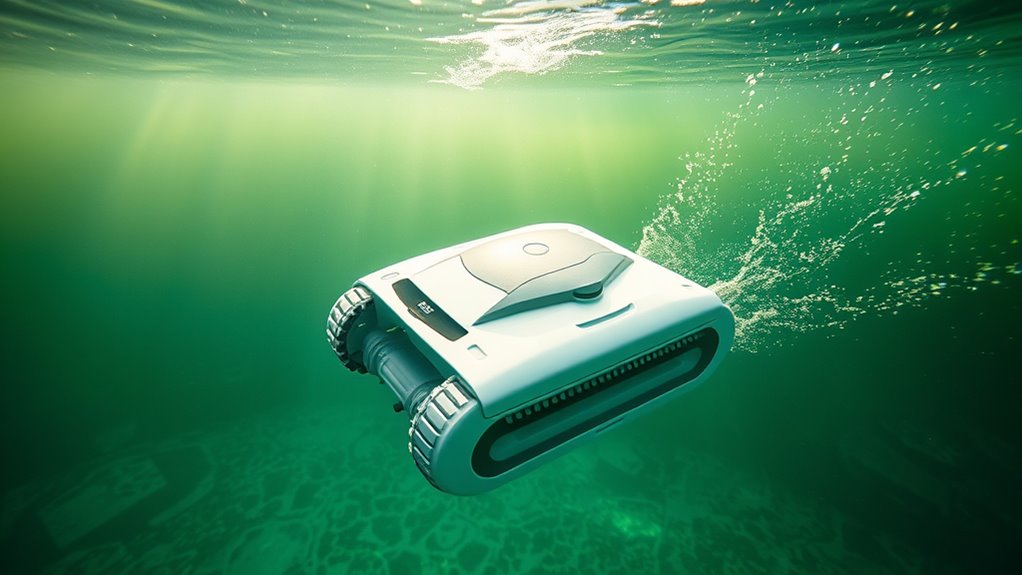
Consistent use of your pool’s automatic cleaner not only keeps surfaces free of debris but also plays a key role in maintaining water clarity. By regularly circulating water, the cleaner helps distribute chemicals evenly, reducing cloudiness. Pairing your cleaner with solar heating can optimize water temperature and promote proper chemical balance, preventing algae growth that clouds the water. Additionally, good pool lighting enhances visibility, making it easier to spot and address cloudiness early. Automated devices also assist in filtering fine particles that cause murkiness, ensuring clearer water. Regular cleaning and proper equipment maintenance work hand-in-hand to keep your pool looking inviting. Incorporating hydrotherapy techniques can further improve water quality and overall pool health. Understanding sound vibrations is essential for optimizing sound-based treatments that can enhance water clarity and health. Utilizing automated pool systems can further streamline maintenance routines and improve overall water quality, ensuring your pool remains crystal clear. Employing water circulation techniques can maximize the effectiveness of automated devices in reducing cloudy water, making your swimming experience more enjoyable and hassle-free. Additionally, selecting the right filter types and maintaining them regularly ensures optimal removal of particles that cause cloudiness and supports consistent water clarity.
Limitations of Automatic Cleaners in Handling Algae and Cloudiness
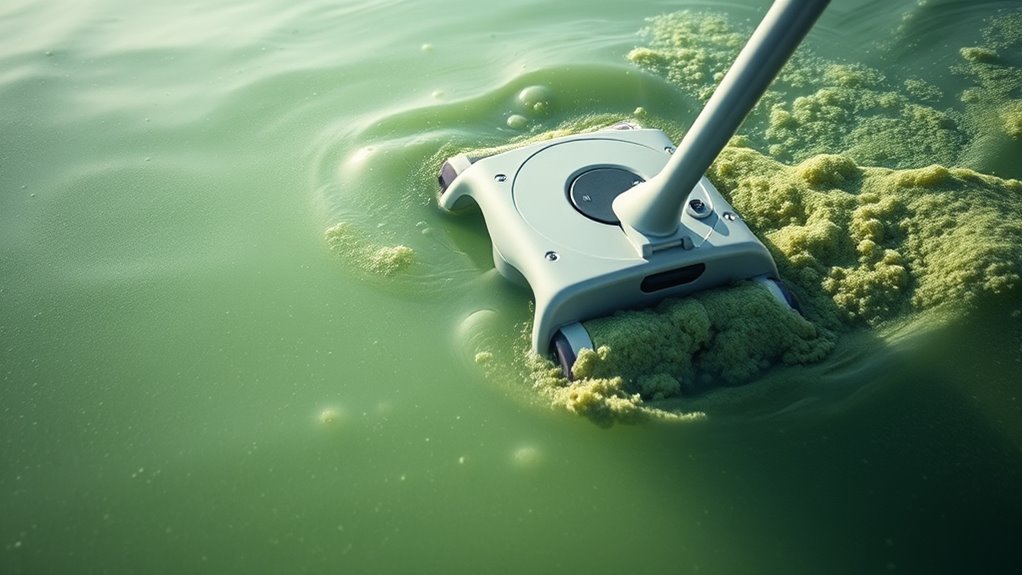
Automatic pool cleaners often struggle to completely remove algae, especially if it’s deeply ingrained or widespread. You might find that cloudiness persists despite regular cleaning, requiring additional treatment. Understanding these limitations can help you better maintain clear, healthy water. Additionally, regular inspection and cleaning of the cleaner’s components can prevent performance issues and extend the lifespan of your equipment. For optimal results, combining automatic cleaning with proper chemical balance is essential to prevent algae growth and water cloudiness. Proper maintenance also involves regularly inspecting and cleaning the cleaner’s components to ensure optimal performance. Incorporating artistic understanding of water chemistry can further enhance your ability to manage water clarity effectively. Staying informed about industry transformations like AI automation and innovative solutions can also lead to better overall pool maintenance strategies.
Algae Removal Challenges
While automatic pool cleaners are effective at removing debris, they often struggle with algae and cloudiness, especially in heavily contaminated water. Algae cling to pool surfaces and can hide in corners, making it difficult for cleaners to reach and eradicate completely. A pool heater can exacerbate algae growth if water chemistry isn’t properly maintained, creating ideal warm conditions for algae to thrive. Automatic cleaners typically lack the ability to adjust chemical levels or treat water chemistry issues, leaving algae untreated. Plus, cloudy water can obscure debris and algae patches, making it harder for cleaners to do their job. As a result, manual scrubbing and chemical treatments are often necessary to eliminate algae and restore clear water, beyond what automatic cleaners can handle alone. Additionally, understanding paint sprayer technology can help homeowners choose the right equipment for other maintenance tasks around the pool area. Proper water testing and chemical balancing are crucial because automatic cleaners are not designed to manage water chemistry issues directly. Regular water testing can help detect imbalances early before they lead to algae outbreaks. Moreover, advancements in automation technology are leading to more integrated pool maintenance solutions that could eventually address some of these limitations.
Cloudiness Persistence
Cloudy water often persists even after debris has been removed by automatic pool cleaners, highlighting their limitations in addressing algae-related issues. These cleaners excel at removing dirt and debris but don’t improve water circulation or break down algae blooms that cause cloudiness. If your water remains murky, a pool heater alone won’t fix the problem; proper filtration and chemical balance are essential. Poor water circulation can lead to stagnant areas where algae and particles settle, making cloudiness worse. Automatic cleaners don’t actively adjust flow or chemical levels, so you’ll need to manually optimize filtration, shock the pool, or use algaecides to clear up cloudy water. In short, maintaining clear water requires more than just automatic cleaning—attention to circulation and chemical treatment is key. Additionally, understanding the importance of attention in creative practice can help pool owners develop better routines for water maintenance and troubleshooting.
Complementary Strategies for Dealing With Algae and Cloudy Pools

Dealing with algae and cloudy pools often requires more than just automatic cleaners; implementing complementary strategies can make a significant difference. Prioritize pool safety by regularly inspecting equipment and maintaining proper filtration to prevent algae growth and cloudiness. Ensuring your pool’s filtration system runs efficiently not only improves water clarity but also boosts energy efficiency, saving you money. Regularly brushing the pool’s surfaces helps dislodge algae and debris, reducing strain on your cleaner and enhancing overall effectiveness. Keep a consistent schedule for running your pump and filter to maintain clean, clear water. These strategies work together with your automatic cleaner, reducing the need for harsh chemicals and manual labor, ultimately creating a safer, more energy-efficient pool environment.
Chemical Treatments and Manual Cleaning: When Are They Necessary?
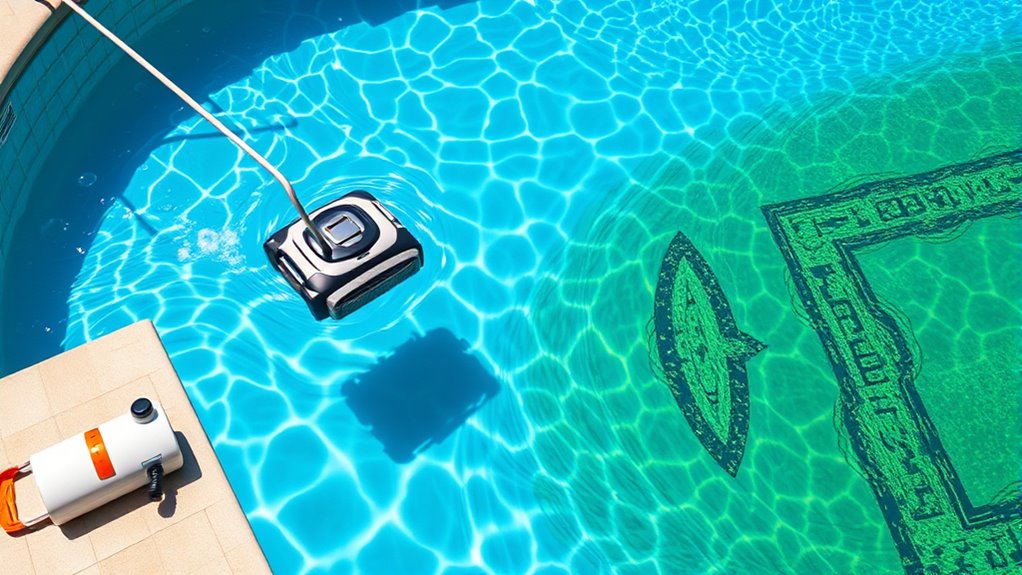
Chemical treatments and manual cleaning become necessary when automatic cleaners and routine maintenance can’t effectively control algae growth or cloudy water. If algae persists despite regular sweeping and filtering, you’ll need to apply specific chemical treatments like algae killers or pH adjusters to restore clarity. Manual cleaning is also essential when algae or debris cling to pool walls or floor, making automatic cleaners less effective. In such cases, brushing surfaces and scrubbing affected areas help break up algae colonies and remove stubborn grime. These steps are vital to prevent algae from spreading or causing more cloudiness. Relying solely on automatic cleaners isn’t enough during severe algae blooms or persistent cloudiness; chemical treatments and manual cleaning are your best options to restore your pool’s cleanliness and clarity.
Tips for Optimizing Automatic Pool Cleaner Performance
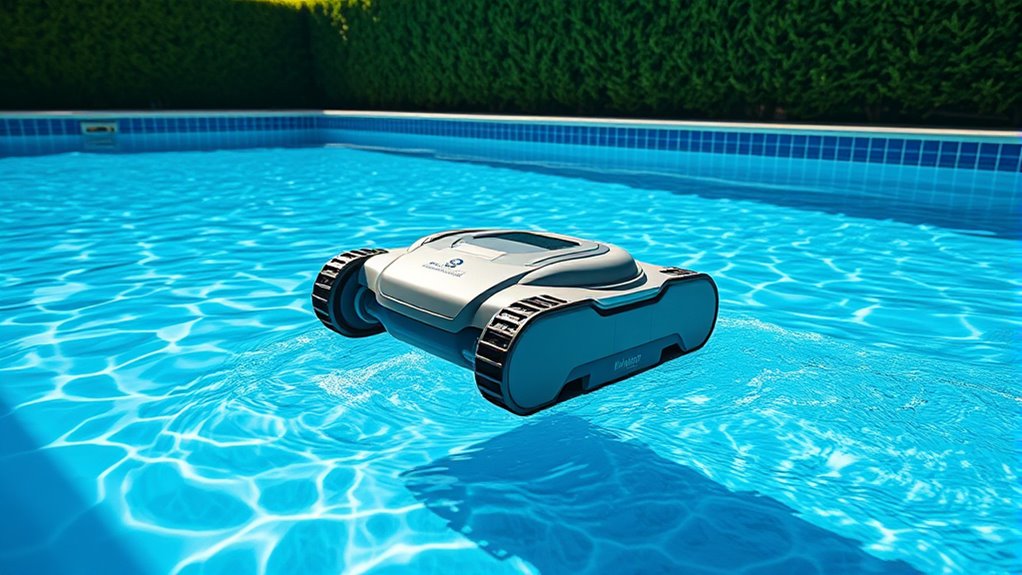
To get your automatic pool cleaner working at its best, proper setup and regular maintenance are key. Start by making certain your pool accessories, like skimmer baskets and brushes, are in good condition and properly installed. Clean or replace filters regularly to maintain suction and efficiency. Stick to a consistent maintenance schedule, checking for debris and cleaning components weekly. Adjust the cleaner’s settings based on your pool’s size and shape for ideal coverage. Remove obstacles from the pool floor that could hinder movement. Keep the water balanced, as proper chemical levels improve cleaner performance. Regularly inspect the cleaner for damage or wear. Following these tips helps guarantee your automatic cleaner operates smoothly, effectively tackling algae, dirt, and cloudy water.
Making the Right Choice for Your Pool Maintenance Needs
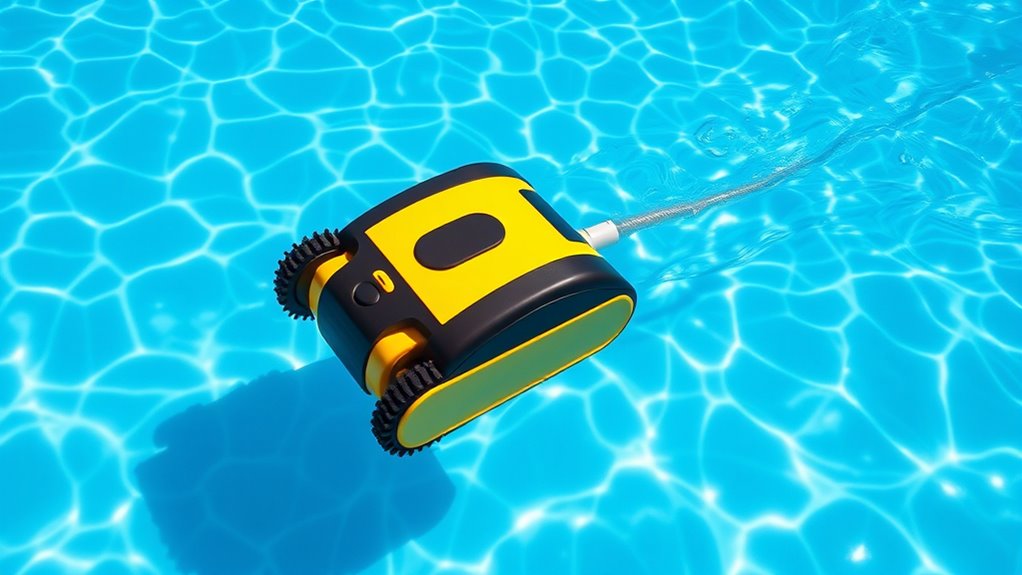
Choosing the right automatic pool cleaner depends on evaluating your pool’s size, shape, and specific cleaning needs. Consider whether you need a cleaner that targets algae buildup or handles cloudy water, as this impacts the model you select. Look for options that prioritize pool safety, such as models with secure brushes and reliable navigation, to prevent accidents. Energy efficiency is also vital; a low-energy cleaner can save you money on electricity bills while maintaining effective cleaning. If you have a larger or irregularly shaped pool, opt for a robotic cleaner with advanced navigation features. For smaller pools, a simpler, less energy-intensive option may suffice. Making the right choice ensures your pool stays clean, safe, and cost-effective to maintain.
Frequently Asked Questions
Can Automatic Pool Cleaners Prevent Algae Outbreaks?
Automatic pool cleaners don’t prevent algae outbreaks directly, but they can help maintain clear water by removing debris and algae spores. To keep algae at bay, you need to focus on proper pool chemistry and stick to regular maintenance schedules. By balancing pH levels, sanitizing effectively, and running your cleaner frequently, you reduce the chances of algae growth, ensuring your pool stays clean and inviting.
How Often Should I Run My Automatic Cleaner During Algae Blooms?
During algae blooms, you should run your automatic cleaner daily to help remove debris and algae buildup. Make sure to maintain proper chemical balancing, especially chlorine levels, to prevent algae growth. You’ll also want to manually brush the pool walls and floor regularly, as the cleaner alone might not reach all spots. This combined approach helps keep your pool clearer and reduces algae faster.
Do Robotic Cleaners Require Special Filters for Algae Removal?
You might think robotic cleaners need special filters for algae removal, but that’s not always true. While regular filters handle most debris well, algae-specific filters can improve performance during algae blooms. Regular filter maintenance is vital to prevent clogging and guarantee efficiency. Using algae-specific filters helps your robotic cleaner target algae more effectively, especially in cloudy pools. Keep your filters clean and replace them as needed for maximum algae control.
Can Automatic Cleaners Clear up Extremely Cloudy Pools?
Automatic pool cleaners can help improve a cloudy pool, but they usually can’t clear it completely on their own. You’ll need to perform chemical treatments to break down particles and algae, and guarantee regular filter maintenance to prevent debris buildup. These steps, combined with your cleaner’s efforts, make the pool clearer faster. Relying solely on the cleaner won’t resolve severe cloudiness; proper chemical balance and filter care are essential.
Are There Specific Models Designed for Algae and Cloudy Water?
You’ll find that some automatic pool cleaners are specifically designed to tackle algae and cloudy water. Look for models with strong scrubbing brushes and advanced filtration systems, which help with algae prevention and remove debris. Regular filter maintenance is essential to keep these cleaners effective. Choosing the right model guarantees you can maintain clarity and prevent algae buildup, making your pool cleaner and more enjoyable.
Conclusion
Think of your pool as a mirror reflecting your care. While automatic cleaners are your loyal guardians, they can’t banish algae or cloudiness alone—they’re just the brushstrokes on your masterpiece. To truly reveal sparkling waters, you must blend these tools with proper chemical treatments and manual efforts. When you nurture your pool with patience and attention, it becomes a crystal-clear reflection of your dedication, shining brightly as a symbol of your commitment.
